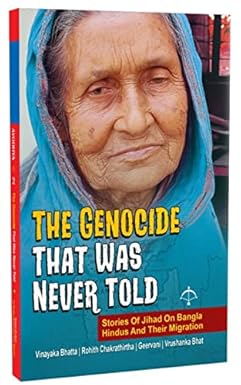It makes up an unending story of brutality incarnate. It is the most heinous epic of inhumanity in the name of religious rights. But to top it all the blightest part of the saga is the cowardice of the Bengali Hindus, the worst victim to hush it up under the carpet (The Genocide That Was Never Told).
In a well-orchestrated pogrom designed to cleanse the Hindu Bengalis physically and culturally from their motherland they inhabited through generations from unknown past. The victim community confronted the gruesome elimination project and opt for a life of homeless destitute, ran from country to country, from province to province unkempt, unfed nomads. But the tragic story was carefully kept hidden from all platforms and the darkest aspect here is the role the educated and the wealthy Hindu Bengalis played. They led the entire Hindu Bengalis in ensuring this kind of suppression of horrific cruelty unleashed on their own community.
And more conspicuously the Hindu Bengalis uprooted from their beloved homeland in East Bengal in a manner that denied them the slightest dignity reserved for humans, once they crossed the border joined majorly the bandwagon of a mode of denial. Not only did they hide the obnoxious story, they helped build up a false narrative that the Muslims didn’t want partition of Bengal. Only Hindus misled by one communal Shyamaprasad carved out a part of United Bengal or Bangladesh for Hindus. This is lock, stock and barrels a Goebbelsian lie for which a completely separate dissertation is required (The Genocide That Was).
The Muslim communal marauders generated waves after waves of barbaric attacks on innocent Hindus since early twentieth century. We desist from covering all genocidal acts perpetrated on Hindus but coming down to 1946 we can’t hold back our emotional attributes to look the other way from referring to the colossal genocidal assaults first during so-called Great Calcutta Killings followed by the Noakhali Massacre exactly two months hence.

The writers in this book have taken up the cases of Hindu genocides by Muslims in post-independence Bangladesh. But the germs of communal hatred against Hindus dates back prior to 1971, the year Bangladesh emerged.
For any historical events there are always two causes—one is the long term and the other short term. The former is not so apparent and is elusive, the other is wide open and easy to discern. Here the long term cause is the one and only one and that of Islamist intolerance which stoops to the lowliest to wipe out others. The short term cause was the plea that Muslims needed a separate homeland. This absurd demand was fuelled by the Communists directly and Nehru-Gandhi duo indirectly.
The numerical minority West Pakistan denied the majority of East Pakistan all political and economic dividends. The latter raised a murmur of protests based on language. The Westerners counted the danger and in a bid to twist the scenario they prompted, assisted, abetted and aided in perpetrating extreme form of anti-Hindu tirades amongst the more fundamentalist Bengali Muslims. They organised concerted attacks upon the non-militant Hindu Bengalis who were unindoctrinated. It began well ahead of March 25, 1971 the day Pakistani military dictators initiated Operation Searchlight.
The smug Bengali Hindus of West Bengal were elated that at long last Bengali Muslims in Bangladesh have woken up to their language-based ethnic identity. It was a daydream.
The Bengali Muslims as is the wont of Islamists didn’t budge an inch from the fundamentals of Islam that is the establishment of Dar-ul-Islam.
Now on to the book under review. The Operation Searchlight offered a weapon in the hands of these fanatic Muslims. In the doldrums of freedom struggle they took the camouflage of rebels and in the milieu launched severe assault on unarmed and guardianless Hindus aided by the Pak military, an all out one.
Also Read : The Koch Kingdom Part 1
Sudip Narayan Ghosh